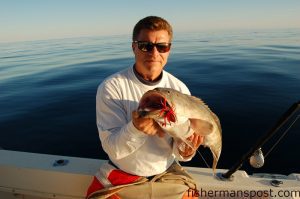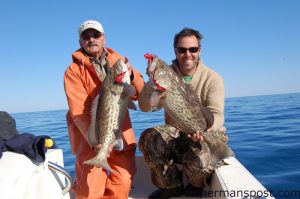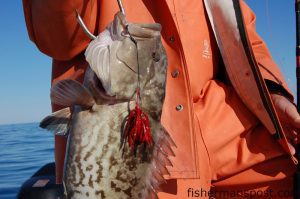The Decoy’s Gag Reflex 2009

Tim Barefoot shows off the desired (and often received) results when a baited Decoy jig is dropped to an offshore ledge.
“There you go, Gary,” Tim Barefoot exclaimed excitedly. “I hear you. That’s a grouper!” How Tim knew this before Gary had made five cranks on the reel handle was beyond me, but I willed him to be right. We’d made a few drops already without connecting with the fish we were looking for, and it was high time someone put a grouper in the boat.
As he continued cranking, the rhythm of the fight seemed right, with lots of dogged pulls towards the bottom and no horizontal movement in the water column, and I joined the grouper consensus. Hurley’s mid-battle grunts could only be taken as a positive sign as well. In just 65′ of water, it didn’t take too long for the fish to appear deep below the boat, only bolstering Tim’s enthusiasm.
“It’s brown! It’s a grouper, man,” Tim continued, staring intently into the sea. “Taylor, give me the gaff!”
Accepting the gaff from his son just as Gary worked the grouper to the surface, the captain planted the big hook under the fish’s jaw and hauled aboard a fat gag grouper that didn’t require any measurement, as it was well above the 24″ minimum size limit. As the grouper hit the deck, I decided that maybe Tim was onto something.
While for many years the standard method of grouper fishing has been bombing the seafloor with baits pinned to bottom rigs and sent down with 12-16 oz. or more of lead on heavy 80+ lb. conventional tackle, the past few years have seen a revolution in grouper tactics. No one disputes that the old method works, but recently anglers have come up with some new ways to target these bottom dwelling brawlers on lighter tackle.
Tim Barefoot’s Decoy System is one of the most effective new methods, and he’d been anxious to show off the technique to us all year. The weather had conspired against us time and again, until late November when we finally boarded his boat blessed with a good forecast and high hopes.
Pulling away from the dock at Masonboro Yacht Club, a dolphin greeted Tim’s 25′ Sea Cat as we made our first turn toward the ICW. Obviously playful, the mammal followed us to the waterway, gliding from the boat’s starboard to port quarters and turning on its side to give us an inquisitive eye through the clear winter water. It was surely a good omen, and I’m certain that all hands on board-Tim, his son Taylor, fishing partner Barry Bobbitt, Gary Hurley, and I-hoped that the gag grouper we were taking off after would be as eager to see the boat as the dolphin was.
As we rounded the corner into Shinn Creek, bound for well beyond the jetties guarding Masonboro Inlet, the soft orange sun brilliantly lit the low clouds hugging the horizon. Taylor and I remarked to each other that it had been a long while since we’d seen such a good sunrise, and I silently chalked that into the good omen column as well.

Barry Bobbitt and Gary Hurley with a pair of gag grouper taken less than 15 miles off Wrightsville Beach on Decoy jigs baited with cigar minnows.
It remained to be seen whether the good omens would lead to a pile of groupers in the Sea Cat’s fish boxes, but the ride out couldn’t have been smoother, with gentle swells rippling under a faint breeze.
Things just kept going our way as I noticed Barefoot slowing down to coast even with some familiar dimpling on the ocean’s now-slick surface about seven miles out of Masonboro. It was bait, and plenty of it. Hurriedly rigging sabiki rigs to two light baitcasters he pulled from the T-Top rod holders, Tim issued one first to Taylor. His rod tip was bouncing under the protests of some prime baitfish before Barry could even get his sabiki into the fray.
The younger Barefoot lifted the cigar minnows and spanish sardine he’d plucked from the ocean to where his dad waited with a dehooker and bucket of water at the transom.
“Got to use the dehooker,” Barefoot said to us as he worked the minnows off the sabiki’s tiny hooks with the wire device. “Two people holding a sabiki rig at one time equals one person hooked.”
Barry soon followed up with more minnows and sardines, and as Barefoot followed the schools of baitfish on the surface and the depthfinder, the two loaded up the leaning post livewell with the prime baits.
“Boston! I got a Boston!” Taylor exclaimed on one drop, displaying that he had a bit of his father’s excitability gene as well. Apparently the Boston mackerel, shimmering fish nearly a foot long, were especially prized grouper snacks, and the bait team managed to land a handful of them to go along with the sardines and minnows darkening the Sea Cat’s well.
We’d taken some live pigfish and spot with us when we left the dock as well, and it didn’t take long for the tank to reach capacity.
With bait a non-issue, Tim pointed the bow to the horizon again, and we moved on to some ledge and live bottom numbers he had around 12 miles off Wrightsville Beach. While this may seem like it was mighty close to shore for some grouper groping, the gags move inshore as the water cools down in the fall and early winter, and Tim seemed confident we’d find some of the fish we were looking for.
Locating the first spot on the depthfinder, he gave Gary and I a quick tutorial on using the Decoy System rigs, which Taylor and Barry were well familiar with, having used them to pry a variety of bottomfish from the depths over the past several years.

The Decoy’s stinger hook found a home in this gag’s jaw. It’s a Mustad assist hook on a braided tether slightly smaller than the jig hook, snaring short-striking grouper and other bottomfish.
“Just put the jig hook through the minnow’s head, and then put the stinger in it back near the tail,” he instructed, a writhing cigar minnow in his left hand.
Gary and I followed suit, and soon we had our rigs descending in freespool to the ledge beneath the boat. It didn’t take long for our baits to find their destination.
“Just let it sit there on the bottom,” Tim continued, eyes on our rod tips. “It’s a jig, but don’t jig it. It looks like a crab, and crabs don’t jump.”
We did as told, but our first few drops only resulted in some just-legal sea bass, prompting Barefoot to explain the rig a bit further.
“See how the bass is hooked onto the stinger hook?” he queried while unhooking a fish. “That’s what it’s for. You hook most of your sea bass, beeliners, and triggers on the stinger. I actually got my biggest grouper on the stinger, too-that’s what really sold me on them.”
While the bass are undeniably tasty, they weren’t what we’d come offshore for (barely come offshore, as the beach was still clearly visible on the horizon), and Tim soon decided to move over to some structure a few hundred yards away.
The move proved sound, as Gary was hooked up to our first gag of the day soon after his Decoy hit the bottom.
Moments after Tim planted the gaff into Gary’s fish, Barry reared back and the tip of his rod dove hard towards the water’s surface. The fish dug furiously to get back to the bottom, but Barry was a handle turn and rod pump ahead of it. He soon gained the first few yards of line that any bottom fisherman knows is vital to winning a grouper battle.
Another good looking hookup sent Tim into an even higher gear, and he was soon sinking the gaff into Barry’s fish as well, an even more sizeable gag than the one Gary put in the boat.
With a pair of gags fresh from the sea on deck, it was time for some photos, and I set my rod in the holder mid-drop to snap a few quick shots. We jockeyed Barry and Gary into the right spot for a photo. As I clicked away, I heard both Barefoots shouting again, but from behind the camera lens it took a moment for me to figure out what was happening.
“Max, you’ve got one, too!” I finally understood, and looked up at the forward starboard rod holder to see my outfit set in a deep bow, thumping up and down with the struggle of a substantial fish.
Crouching on the other side of the boat with an expensive camera in hand, I was in no position to react quickly, but Taylor was. “Taylor, grab it!” I shouted, discovering that a flurry of grouper activity gets more than just the Barefoot men worked up.
He pried the rod from the holder, and Taylor soon worked another gag boatside to his father’s waiting gaff, slightly smaller than the first two fish, but legal nonetheless. My Decoy hadn’t even reached the bottom yet, which may be why the gag was unable to find some structure to cut the line on before Taylor got to the rod.
On the strength of three groupers in the boat in less than five minutes, I was definitely sold on the Decoy System. At the heart of the system is the Decoy jighead, an unusually shaped head that Barefoot spent well over a year developing and refining.
“I bet I’ve got a hundred hours in just getting the balance right,” Tim explained, turning one of the heads over in his hands before tying it onto another rod. “The balance makes it much more snag resistant.”
A silicone skirt is attached to the head, and the planing wings on the sides of the jig give it the strong appearance of a crab, especially in the red color we were using, as most of the invertebrates and other creatures inhabiting offshore bottom structure share a similar red/brown color scheme. With a minnow pinned to the jig hook, the rig takes on the appearance of a crab that has grabbed a fish, hence the Decoy name.
“The jig is the same as the Gitzem head we use inshore, but my passion’s always been bottom fishing, and I decided I wanted to imitate a crab. I was trying to tap into the psychology of a fish’s world,” Barefoot explained to me while piloting the boat between spots.
“These fish see a chicken rig with a big bank sinker all the time, but if they think they see a crab that’s gotten a minnow, that sight is more than their psychology can handle, and they just crush it. They think they’re getting two things at once.”
The stinger hook, a Mustad assist hook rigged on a short Kevlar tether, is attached to the main hook of the jig and buried in the bait’s tail, allowing anglers to hook the smaller fish that manage to avoid the large main hook on the jig. It performed admirably in this job, allowing all of us to hook sea bass, grunts, and other smaller bottom dwellers that would have simply resulted in stolen baits absent the stinger.
In addition to the Crab Decoy, Tim’s also offering models that imitate squid and octopus that have secured a meal, in both 4 and 6 oz. sizes.
The Decoy jig alone does not a system make, as it also involves specialized tackle as well. The jig is tied with a loop knot to a 100-130 lb. fluorocarbon leader and 65-80 lb. braided line. The braid reduces the line’s water resistance manyfold over heavy mono, allowing anglers to use a 4 oz. Decoy jig down to 150′ with mild currents.
Daiwa Saltist 30 and 40 reels on 50-80 lb. stand up rods complete the system. Tim has a line of rods made specifically for the Decoy that will be available soon.
I’m used to grouper fishing with the standard chicken rig, a pound of lead, and a 6/0 reel, and it’s amazing what a difference fishing with the lighter gear makes. Cranking a 4 oz. weight to the surface feels effortless compared to one four times as heavy, and the 6:1 retrieve ratio of the Saltists enables one to burn the jigs to the surface at warp speeds compared to clunky, older style conventional reels.
The lighter gear also makes the fight of a big grouper even more exciting, although the stand up rods and braid work together to provide plenty of power to move a stubborn fish off the bottom.
My faith in the Decoy method of grouper digging complete, I hurried to drop another bait to the bottom, coming up with another sea bass this time.
As we’d drifted away from the bite, Tim put us back in the zone, and Barry quickly added another stout gag to the box.
I followed up with what felt like a promising hookup, and was pleased when my first gag of the day appeared in the clear water below the boat. We continued dropping baits on ledges and other bottom structure just 10-12 miles off the beach for the next several hours, hooking more gags, more and larger sea bass, and some hefty grunts, along with a few dreaded sharks.
Tim prefers a variety of live baits for the Decoy System, and I’m in no position to argue, as I believe we caught keeper gags on the cigars, sardines, and mackerel we’d jigged up on the way out. However, dead baits work as well, and frozen cigar minnows have been responsible for plenty of catches on the rig.
Grouper fishing, particularly near the beaches, is at its best in the fall and early winter, and the results of our trip reiterated that fact. Unfortunately, anglers should pack in as much grouper digging as they can before the New Year, as the South Atlantic Fisheries Management Council has enacted a closure for all shallow water grouper fishing from January to April of next year, based on scientific research that most anglers feel is controversial at best.
Fighting a closure like this is no easy task, but fishermen fortunately have several organizations on their side, perhaps most importantly the Recreational Fishing Alliance (RFA), an organization dedicated to protecting the rights of recreational fishermen in the face of increasing political pressure from commercial fishing and environmental groups. Tim Barefoot serves as the North Carolina chair for the organization, and he explained how important it is to anglers in the state and around the country.
“The groups fighting against us have had the political tools to accomplish their agendas for quite some time,” explains Barefoot, “and the RFA is all about giving recreational anglers the same tools and making sure our rights are not ignored.”
While the grouper closure is likely a done deal, joining the RFA is something recreational anglers can do to protect their rights in the face of tightening pressure from a variety of sources. Anglers can learn more at www.joinRFA.org.
As the sun neared the horizon and Tim bumped up the Sea Cat’s throttles for the blissfully short ride back to Wrightsville Beach, I decided he’d been justified in his eagerness to show off his unique grouper system, and that the morning’s good omens had been honest. Though we were in shallow water looking only for gags, the method has proven quite effective on red and scamp groupers along with other bottom dwellers in deeper water.
With the advent and explosion of butterfly jigging and the Decoy System, anglers have several new and innovative ways to target bottomfish, but Barefoot is confident his is the greatest, even going so far as to offer a challenge to butterfly jig devotees.
“I want somebody to bring their best two-man butterfly jigging team,” he explained, grinning confidently, “and come onboard with me. I’ll bring two guys to fish the Decoy. When we get to a limit of grouper, if they catch more of the fish, I’ll pay for the fuel and they can have the fish. If my guys catch more, we keep the fish and you pay for the fuel. Nobody’s taken me up on it yet, but the challenge is out there.”
Tim will be speaking about and demonstrating the Decoy System over the winter at boat shows in Greensboro, Raleigh, and Richmond, VA. Anglers who can’t make the boat shows can learn more about the Decoys by visiting Tim’s website at www.barefootfishing.net.
